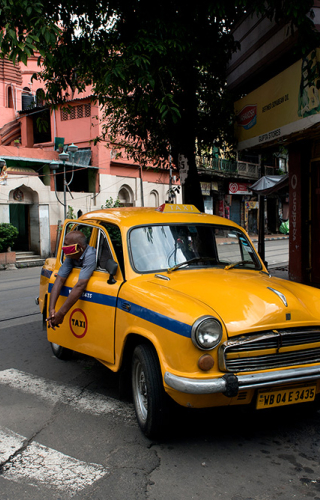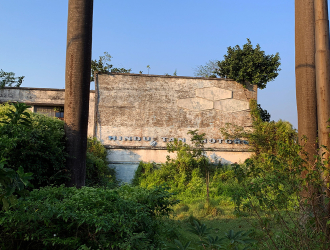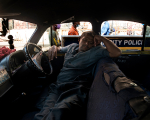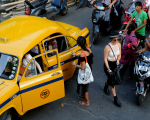As a child, I grew up watching the iconic yellow Hindustan Ambassador taxis from the balcony of my first-floor residence in Bhowanipore, in South Kolkata: sometimes a quarrel would break out between the owner of the car and the driver over fuel theft; sometimes I could hear a loud ‘Taxi!’ call the typical way of stopping a passing taxi; or on my way out, I would pass by a group of Bihari taxi drivers loudly engaged in a game of cards on the footpath.
In fact, my para (neighborhood), Bhowanipore, is known as the birthplace of the yellow taxi, popularly known as taxi para even today. In the 80s, almost all middle-class Bengali families residing in this para had one or two taxis rented out as an additional source of income. Drivers, mostly migrants from Bihar, rented taxis on a contractual basis. In the early 60s, when Hindustan Ambassador taxis first hit the streets, drivers were mostly from the Sikh community. During that time, Bhowanipore had a high number of Sikhs, and most of them were involved in the transport business. They were popularly known as ‘Sardarji’ and they ruled Kolkata’s chaotic roads till the early 90s.
Daljinder Singh, 48, recalls childhood memories of his grandfather, late Sardar Sarjit Singh Grewal, buying a second-hand Ambassador taxi in 1970 at a price of Rs. 7,000. It was driven by his father, late Sukdev Singh Grewal. With a glint in his eyes, he proudly asserts how Sardarji taxi drivers were in great demand for their high standard of honesty. They never cheated an unsuspecting traveller arriving from other cities and always ran on meter, using the shortest possible route. Because they only accepted the metered fare, they became popular among the middle class, who were not rich enough to own a car, but were willing to pay more for a comfortable ride. Daljiner Singh is now the owner of S.K Motors and still runs a Hindustan Ambassador repair shop at Townshend Road in Bhowanipore.
However, most Sikh taxi drivers have now taken up alternative professions and moved away from the taxi business. Those who still drive, are shifting to Ola and Uber taxis. In 2020, you can hardly find a Sardarji taxi driver in Kolkata. One such rare person is Jagdev Singh, born in Kolkata in 1949. He has been driving his own Hindustan Ambassador taxi since 1970. He says that back in the 70s, it was very difficult to get a commercial driving license and he failed twice before securing his driving license on December 7, 1970. Jagdevji was once the proud owner of seven yellow taxis but he has sold them all, except the one he drives. None of his sons is interested in this business and has opted for other jobs. Without reliable drivers available, he couldn’t rent his other taxis. When I asked about how times have changed, Jagdevji reflected that earlier the police didn’t enforce law and order and crime was rampant on the streets, so Bengali housewives and young girls would prefer to ride taxis after evening only with Sikh drivers because they had impeccable trust in them. In his 70s now, Jagdevji usually starts his beat in the dead of night, at 2 AM, and returns home around 10 AM to avoid heavy traffic and pollution. He admits this late-night driving has its share of risks, especially from street criminals. In 2007, a gang of three made an attempt to hijack his taxi. Using his kirpan, Jagdevji courageously nabbed one hijacker and handed him over to the local police station.
In the 80s, rows of Hindustan Ambassador taxis queued up in front of the Oberoi Grand Hotel on the Esplanade or at the Howrah Station. Kolkata’s varied modes of transportation were an essential feature of the city’s urban character as much as the hand-pulled rickshaw, electric trams and the Metro Rail. They have been immortalised in movies by renowned directors like Satyajit Ray and Aparna Sen. Kolkatans can recall stories when the taxi gave them privacy to steal a kiss in the back seat while being driven around the city. Many love marriages had their beginnings in secret rendezvous in taxis. The fondness Kolkatans have for the yellow taxi has made it an icon of the city.
Taxis had been operational in Kolkata long before Independence. However, post-Independence, in what was a major landmark in India’s journey to self-reliance, the Hindustan Motors factory was set up in Uttarpara (18 km from Kolkata) in 1948, as part of the Birla Technical Services industrial group. Hindustan Motors started production of the Ambassador (based on the 1956 Morris Oxford series III) in 1958, conceptualised by British automotive designer Sir Alexander Issigonis, whose other famous creations were Mini and Morris Minor. Hindustan Ambassador quickly became popular for its classic design and spacious interior. It became the vehicle of choice for all government transport and was assigned to politicians for travel. In 1962, the Calcutta Taxi Association took the initiative to convert the Hindustan Ambassador to a taxi. “It’s sturdy build suited driving on Indian roads,” says Taraknath Barik, who has been with the Kolkata Taxi Association for over five decades. Since taxis had to be visible from a distance, the colour yellow was chosen as it is easiest to spot, even at night. Hindustan Ambassador upgraded models over the years starting with Mark I (1957–62), followed by Mark II (1962–75), Mark III (1975–79), Mark IV (1979–90), Nova (1990), Classic (1992), Grand (2003) and Avigo (2004). By this time sales had plunged and the monopoly of Hindustan Motors as a car manufacturer was over. Facing unsustainable losses, they launched their last model, the Ambassador Encore in 2013, but it failed to revive the fortune of the brand. On May 24, 2014, the last Hindustan Ambassador rolled off the assembly line, ending a golden era of Indian automobile history.
Hindustan Motors’ fate was sealed in 1991 when the economy was liberalised, bringing an end to decades of protective license raj. The Indian consumer now had higher income and greater spending power to buy a personal car. This reduced public dependence on taxis and made the car industry highly competitive with the entry of foreign brands. In the last decade, with increasing penetration of digital connectivity, app-based services and mobile phone usage, new pressure has emerged with the entry of cab aggregator services like Ola and Uber. Low fares offered by these taxi-hailing services, combined with a wide choice of cars, GPS tracking, quick booking, professional drivers, safety features for women and in-car entertainment, have made the survival of yellow taxis even direr.
Closure of Hindustan Motors factory caused severe hardship for taxis still in service. With no new auxiliary parts available in the hardware market, repairing Hindustan Ambassadors has become a specialised task, and only a handful of mechanics can fix old models. While several thousand yellow taxis are still plying the city streets, the government has made it mandatory for commercial vehicles which are older than 15 years (from the year of registration) to be discontinued. This way, old Hindustan Ambassadors are being phased out in the next 5 to 8 years to reduce diesel pollution.
Lastly, the COVID-19 pandemic in 2020 has dealt a crippling blow to the yellow taxi business. The pandemic brought about complete lockdowns for many months, and migrant drivers from outside Kolkata were stuck without work or any way to return home. Though lockdown has now been lifted, people do not venture out of their homes. Offices have closed and most people work from home, thus depriving taxis of their daily office commuters. Similarly, with tourism services closed, travellers at railway stations and airports have sharply reduced. Kailash Kamat, 44, who lives in a ghetto with other taxi drivers in South Kolkata, complains about the lack of passengers post-lockdown. Earning Rs. 500 in a day is now a challenge, of which he has to pay the taxi owner Rs. 400 for daily rent. If this situation continues, Kailash sighs, he will have to quit taxi driving.
Amidst the doom, the only silver lining that has emerged is the merger of app-based cab aggregator services with yellow taxis. According to Ola, in 2015, around 1,000 yellow taxis registered with them and they expected more than 5,000 taxis in their fleet by the end of that year. Even this integration will benefit only 1/5th of the yellow taxis in the city, which is estimated to be around 26,000 strong. Registered yellow taxis can now be booked through the Ola app and specially trained drivers are equipped with smartphones that enable them to receive booking requests and reach customers at his/her doorstep. Customers can pay the fare either through cash or Ola’s mobile wallet service. This innovation is the last chance to save the yellow taxis, but with strict enforcement of pollution control measures, it is only a matter of time before they disappear from the roads of Kolkata.
This photo-essay has been created as part of the Sahapedia Frames Photography Grant, supported by CSR funding from IndusInd Bank.
















